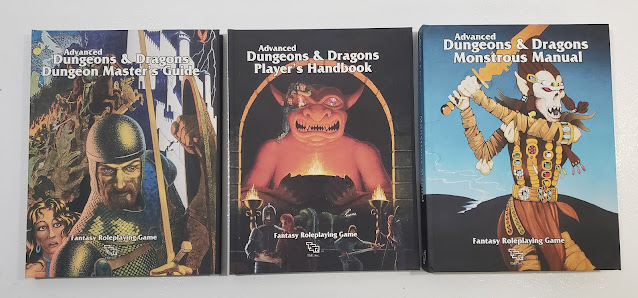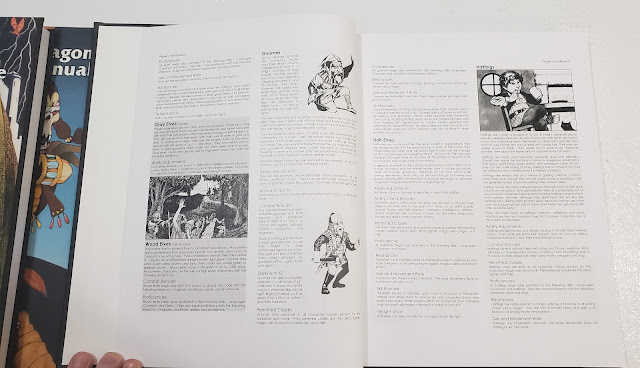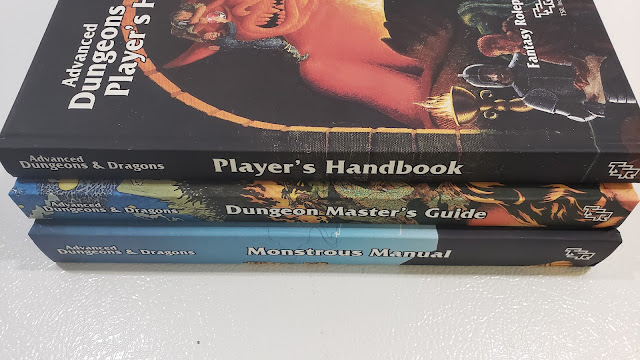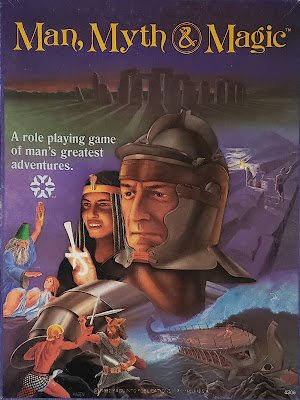I am going to be spending some quality time with the classic game
Man, Myth & Magic by
Herbert "Herbie" Brennan and J. Stephen Peek and published originally byYaquinto Publications in 1982, and now published (in PDF and single softcover formats) by Precis Intermedia.
I was always kind of fascinated by this game. The name of course grabbed me for two reasons. There was the whole "Myth and Magic" side to it all which in 1982 was a big draw for me. Also, there was the magazine and encyclopedia series also called Man, Myth & Magic that dealt with all sorts of occult-related topics.
I read reviews for it in Dragon Magazine (#80) and White Dwarf (#41) and was actually quite curious about it. The reviews really ripped into the game and I needed to know if it was as bad as they made it sound. Sadly I never found a copy near me and a mail-order of $19.00 + tax and shipping and handling made it a little more out of reach when it was new.
But I was always drawn to historical games. I felt if I could play or run a game and learn something about history at the same time then it was time well spent really. A few I have enjoyed quite a lot, mostly Victorian-era ones, and others I ripped online so much I promised I wasn't going to rip on them anymore.
Man, Myth, & Magic sadly belongs to the camp of a historical mishmash, that is to say, it is about as historically accurate as an episode of Xena: Warrior Princess. Don't get me wrong, I love me some Xena and it is very entertaining in the right frame of mind. The same is true for this game. Great, in the right frame of mind. In fact, I think that now, living in a post-Xena world, there is a place for this game that did not exist in 1982.
For this review, I am going to consider my original boxed set from 1982 (now minus the dice) and the newer PDF versions found on DriveThruRPG published by Precis Intermedia. In both cases, the material is the same minus some of the extras that came in the boxed set like the dice and a pad of character sheets.
Man, Myth, & Magic
Man, Myth, & Magic was published in a boxed set of three books (same covers), with a pad of character sheets, some maps, and dice. The PDF combines the three books into one 132 page volume. The original boxed set retailed for $19.00 in 1982 ($55 in today's buying power) and the PDFs sell for $7.95 today. The books feature color covers and black & white interiors.
Book 1
Book 1 is 24 pages and covers the "Basic Game" and the game most like the one as originally conceived of by Herbie Brennan. In this game, the players play gladiators in the time of the Roman Emperors. Which one? That is up to a random dice roll unless of course, the players want something different.
It's an interesting idea, but...well there are some problems here. According to the back of the box, it is the Summer of 41 CE. Cool. But Caligula was assassinated in January of 41 CE. Tiberius ruled 14 to 37 CE and Nero was Emperor from 54 to 68 CE. The only Emperor in the Summer of 41 was Claudius. Adding dates in parentheses would have been a nice touch. Let's not even get into the fact that Cleopatra VII, the last of the Egyptian Pharaohs, had died back in 30 BCE, 71 years before the events of this game, but that looks like her on the cover. I'll talk more about this later. In theory you can tun this game from 4000 BCE to 500 (or 1000) CE.
You begin with your Roman Gladiator and your two percentile d20s and roll up your characteristics. The characteristics in the Basic Game are Strength, Speed, Skill (not used just yet), Endurance, Intelligence, and Courage. The scores range from 1 to 100. You add all these up for your Life Points (so 5 to 500), you fall unconscious at 20 or below and dead at 0 or below.
The Basic rules take your gladiator from start to a bit of combat and adventure with the maxim that the best way to learn is to do. This is a tactic that the rest of the game uses. At the end of this, your character is ready for new adventures.
The neat bit, and one I want to revisit, is the idea of reincarnation. That is if your character dies they can be reincarnated.
Book 2
Book 2 covers the "Advanced Game" and includes 40 pages. Here we learn more about skills, the Power score, and the different Nationalities (10) and Classes associated with each (2-5 each). All are completely random and no real attempt is made to explain why say an Egyptian Sorcerer, a Gaulish Barbarian, a Roman Gladiator, and a Hibernian Leprechaun would all be part of the same adventuring party. Ok. That's not entirely true, but the explanation takes some digging.
Up first is determining your Nationality. Again a random roll gives you African, Briton, Egyptian, Gaul, Greek, Hebrew, Hibernian, Visigoth, Roman, and Oriental. Each at 10% chance. Within each nationality, there are character classes. Regardless of how many there is an equal chance for any given class. Most nationalities have a sort of "fighter" like class and all have merchant. There are two classes open to women characters only, Wisewoman (African) and Sybil (Greek). Details are given for all the classes, 20 in total, but not a lot of information. In most cases only a paragraph here and some more details later on. This brings up a persistent issue, the rules are a bit scattered everywhere throughout the book.
Additionally, there are two "Special Categories" of players (not characters) of "Orator" and "Sage" or essentially a storyteller and a record keeper. Much in the same way Basic D&D has a "Caller." Not much else is mentioned about these roles however.
This character is considered to be your first incarnation. Anytime your character dies, you can then reincarnate. This allows you to change your nationality, class, and gender and retain a little bit of the Skill from a previous incarnation. It is an interesting idea, I am not 100% certain though that it works. Knowing gamers I see a situation where players would play a character only to get them to die for a chance at a better character next time.
There is a fun chart on inheritance that would be fun to port over to other games. Related there are our ubiquitous tables of equipment.
Some of the other secondary "Optional" characteristics are also detailed. These include Agility, Charm, Dexterity, Drinking, and so on. These are really more akin to "skills." The trouble is that some of these you have to roll higher, some you have to roll lower and others you don't roll at all. There is no rhyme or reason here.
Combat rules follow and they remind me a bit of Runequest. Nothing really special really. Strength points over 50 can add to your damage, Skill points over 50 can add to your "To hit" chance. Combat, like all the rolls here, start with a basic 50% chance to hit. The Basic game just has you roll. The Advanced game has you make called shots. Classes with Combat as their "Prime Ability" can improve their ability to hit even more. All classes can spend Power to also increase their to-hit bonus; 10 points of Power to increase your chance by 1%. Interestingly armor does not stop you from being hit, it does reduce damage taken.
The goal of the game though is the accumulation of Power. Power advances your character and can overcome that 50% failure rate. Power also is the, well, power behind Magic.
The last third or so of the book covers all sorts of additional rules. Some seem tossed in, to be honest. Poisons are covered as are spells.
Magic, as expected, is given some special attention, though not as much as I was expecting. Magic is assumed to be real and work, at least part of the time. Magic is described as "Coincidence," a spell is uttered and something happens whether it caused it or not. "Science," Damascus steel is given an example. The superior technology was seen as magic. "Psychic Phenomena" which not really an explanation at all, likewise "Trance State" and as "Lost Knowledge." Though no explanation is really given as to how magic works.
Book 3
The adventures take up Book 3 and is 64 pages. This book is for the Lore Master (Game Master) only and is also one of the weaker parts of the game. The Adventures, while interesting, are a bit of a railroad. In order to succeed the players have to hit all the parts in order and then move on to the next adventure.
The adventures include the following:
- The Dragon Loose in Rome. Not a dragon really, but a rogue T-Rex. Not that this makes any more sense, but ok, points for effort.
- Apollo's Temple. Emperor Caligula sends the characters to the Temple of Apollo aka Stonehenge.
- The Witches of Lolag Shlige. The characters then have to go to Ireland (Hibernia) and rescue a child from some witches.
- The Great Pyramid Revealed. Caligula has issued a death warrant for the characters. They find themselves in the Great Pyramid of Giza.
These adventures are a prelude to the published adventures. There are some neat ideas here, but the adventures lack something for me. Actually, it lacks a lot of things for me, but I could make some changes to make them work.
There are some encounter tables, but they only cover the areas that the adventures are detailed here. I also have to note there are no monsters here. Just humans.
One of the bigger criticisms of this game at the time was the then $19.00 price tag, about $55 in today's buying power. Now $20 for a boxed set of three books, character sheets, and dice sounds like a steal. With the PDF at just $7.95 it is at a price I think should attract anyone that might have been interested in this game.
The art is in black & white, which is expected and welcome, but there is not a lot of it and some of it is repeated throughout the books.
Man, Myth, & Magic at times feels like two different games, or rather two different ideas merged into one game. I feel that the classic Roman Gladiator/Basic Game was Herbie Brennan's idea and the worldwide game of various nations and types or the Advanced Game was Steve Peek's. Given that Brennan started working on a game called "Arena" which was a Gladitorial RPG.
About Reincarnation
Reincarnation is quite a big deal in this game. This is not a huge surprise given Herbert Brennan's publication history. His book "The Reincarnation Workbook: A Complete Course in Recalling Past Lives" could work as a guide for this game. Personally, I would like to use the reincarnation idea to help smooth out some of the issues with different times. So adventurers from Cleopatra VII's Egypt, can then deal with Tiberius, and then help in Boudicea's raid on Londinium. Something similar to the Old Soul quality in Unisystem.
Somehow using the idea of the Distant Memory which, like Old Soul, allows the characters to draw on past life knowledge and skill. That is easy to do in Unisystem, not so easy to do in D&D like games with very rigidly defined classes. Maybe taking a level in another class might do it.
I am sure there is more in the expansion, The Egyptian Campaign, but I don't have access to that set right now.
There is an interesting game here but I think the concept of it is greater than the rules as presented actually allow. It never quite lives up to what the box claims. Nor is it the abomination that earlier reviews made it out to be. I think most reviewers balked at the price tag and the fact that the game did not offer anything new; at least not anything that meant going through the rather clunky rules.
It is most certainly not a historically accurate game. Historically inspired to be sure, but not by any means accurate.
The bottom line is that the game really isn't good, in fact, it is rather bad in many respects. That is not to say that someone won't find this game interesting or fun. I just think that there are far, far better games out there.
Should you buy it?
I would say the PDF at just under $8 makes it worthwhile for the very, very curious. I have my boxed set and I am happy with it, but my expectations were low and my curiosity was really high.
The game itself is only worth about 2 stars. My curiosity about it and my desire to have pushed it closer to 4 stars. In the end, I am going to give 3 stars since I don't want to unduly affect Precis Intermedia games' overall rating. But don't grab this unless you are really curious (which is a good reason) or want to see how not to design a game.
Links





























